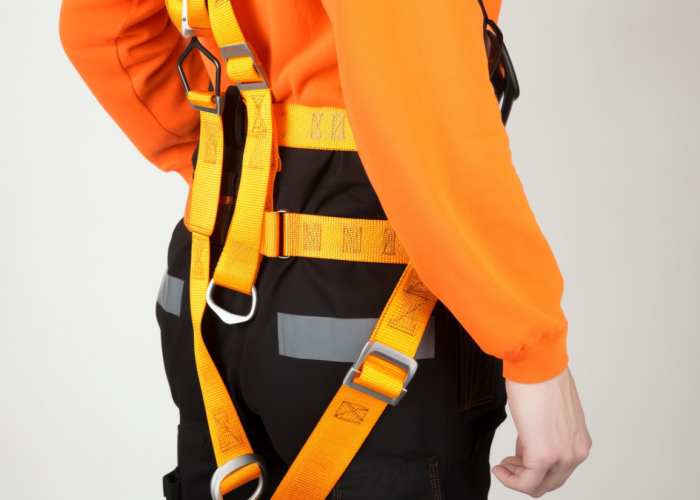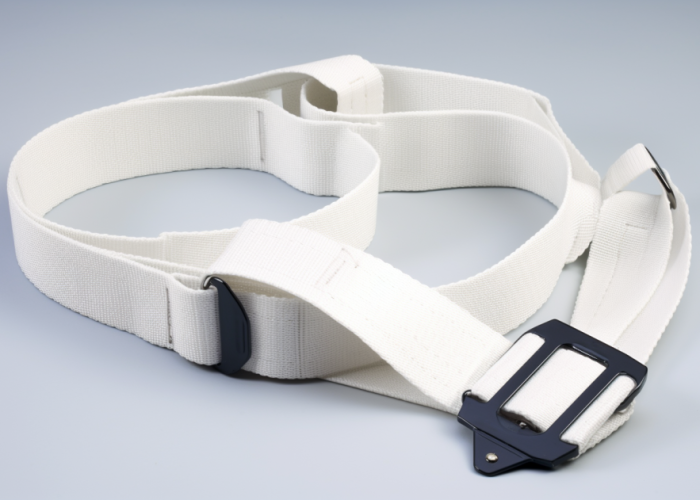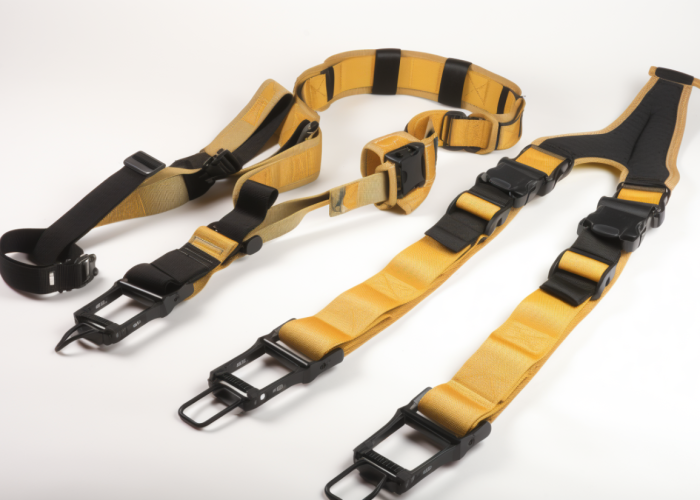Patient lifting and transfer equipment requires reliable components that ensure both safety and comfort. Understanding the critical specifications of sling straps is essential for medical equipment manufacturers developing products that healthcare facilities rely on daily. Our advanced manufacturing capabilities enable custom webbing solutions tailored precisely to your product requirements.
Patient sling straps are integral components of patient lift slings designed to safely support and transfer patients with limited mobility. These specialized webbing straps attach the sling to a patient lift device and help distribute the patient’s weight evenly during transfers between locations, such as from bed to chair, wheelchair, or toilet, while ensuring patient safety and comfort.
Explore key specs for patient sling straps—materials, sizes, safety, and custom options—to improve device performance, caregiver efficiency, and patient comfort.


Webbing manufacturing expert with 15+ years of experience helping product developers build high-performance straps for industrial, medical, and outdoor use.
Patient sling straps are primarily made from polyester, nylon, mesh, padded fabric, non-woven disposable materials, fleece, and specialty moisture-proof linings. Each material offers unique properties suited to specific care needs, with selection depending on required durability, comfort, and infection control considerations.
Key Materials at a Glance:
Polyester stands as the most common material for patient sling straps, recognized for its exceptional durability, strength, and ease of cleaning. Its resistance to moisture and chemicals makes it particularly suitable for healthcare environments where sanitization protocols are stringent, while maintaining structural integrity even after repeated use.
Nylon sling straps provide an excellent balance between comfort and durability with added softness and strength. Its natural elasticity creates slight give under pressure, distributing weight more evenly across contact points during patient transfers—a critical feature for preventing pressure injuries during movement.
Mesh materials constructed from breathable polyester mesh excel in bathing or high-moisture situations. The open-weave construction dries rapidly, prevents skin irritation through air circulation, and allows caregivers to visually monitor skin condition during transfers—essential for patients with compromised skin integrity.
Specialty options include padded fabrics with additional cushioning under pressure points, non-woven polypropylene for single-patient disposable applications, synthetic fleece for enhanced comfort with sensitive skin, and moisture-proof linings like Sure Chek for superior infection control where bodily fluids may be present.

Patient sling straps come in a range of standardized sizes from XS to XXL/3XL+ with color-coded identification to accommodate different body types and weights. Sizing is typically determined by the patient’s body length and weight, with each size category corresponding to a specific weight range and color code for quick visual identification by caregivers.
Size Categories Overview:
Standard adult sizing follows a consistent progression from extra small through 3XL+, with each increment accommodating approximately 50-100 additional pounds of weight capacity. This standardized approach aligns with ISO 10535 requirements for patient lift devices and accessories, ensuring compatibility across healthcare environments from acute care facilities to rehabilitation centers and long-term care settings.
Specialized pediatric sling sizes are also available for children, featuring smaller dimensions and appropriate weight capacities for younger patients. These pediatric options maintain the same safety features as adult versions but are proportionally scaled to ensure proper support and pressure distribution for smaller bodies, particularly important in pediatric hospitals and children’s rehabilitation facilities.
Size Weight Range (lbs) Max Load Rating (lbs) Color Code Typical Length Common Applications
XS Up to 75 150 Brown 36″-40″ Pediatric/Small Adult
S 75–125 200 Red 40″-50″ Standard Transfer/Positioning
M 125–175 250 Yellow 50″-60″ Daily Care/Rehabilitation
L 175–275 350 Green 60″-65″ Standard Bariatric/Positioning
XL 275–350 425 Blue 65″-70″ Bariatric Transfer/Positioning
XXL/3XL+ 350–600+ 850 Black 70″+ Specialized Bariatric Care
Bariatric sling straps represent the upper end of the sizing spectrum, engineered to support up to 600-850 lbs with extra-large sizing. These specialized straps feature reinforced construction with additional webbing layers or higher tensile strength materials to safely accommodate higher weight loads while maintaining patient comfort and caregiver ease of use in specialized bariatric care units.
Length and width dimensions vary by manufacturer and model, with typical sling straps ranging from 36″ to 70″ in length and 2″ to 4-5″ in width. These dimensions can be customized based on specific product requirements to accommodate different lift designs and positioning needs while ensuring even weight distribution and patient security.
Need custom sizing options or specialized color coding for your patient handling products? Contact us to discuss your specific manufacturing requirements.
Color coding is widely used for patient sling straps to indicate size and ensure quick, correct selection by caregivers in fast-paced healthcare environments. This standardized visual system helps prevent sizing errors that could compromise patient safety while streamlining the selection process for staff during transfers.
Standard Color Code System:
The color-coding system follows international conventions recognized in healthcare facilities worldwide, aligned with ISO 10535 recommendations for patient handling equipment. This standardization is particularly valuable in acute care hospitals and rehabilitation centers where staff must quickly identify appropriate equipment during patient transfers.
Color Size Max Load Rating (lbs) Visual Identification Application Settings
Brown XS 150 Full edge binding Pediatric units, small adult care
Red S 200 Edge binding or tags Rehabilitation centers, home care
Yellow M 250 Edge binding or tags General hospital units, long-term care
Green L 350 Edge binding or tags General hospital units, long-term care
Blue XL 425 Edge binding or tags Bariatric units, specialized care
Black XXL+ 850 Full edge binding Specialized bariatric care centers
While the straps themselves are typically manufactured in neutral colors (often black or dark-colored for durability), the color-coded edges or binding provide the necessary visual identification without compromising the structural integrity of the webbing. This approach allows medical equipment designers to maintain a professional appearance while incorporating essential safety features.
Color identification systems extend beyond mere convenience—they serve as a critical safety mechanism in preventing the use of undersized slings for larger patients, which could result in equipment failure or patient injury. Similarly, they prevent the selection of oversized slings for smaller patients, which could create positioning issues or increase fall risks during transfers.
The contrasting colors on sling edges also provide visual cues that help caregivers ensure proper strap alignment and correct attachment to lift mechanisms, further enhancing patient safety during positioning and transfers in acute care hospitals, rehabilitation facilities, and long-term care settings.
Patient sling straps feature varying thickness specifications from a few millimeters to over a centimeter, with lengths typically ranging from 36″ to 70″ depending on size category and application. These dimensional specifications ensure optimal safety, durability, and patient comfort across different usage scenarios.
Dimensional Specifications:
Thickness specifications typically feature reinforced, heavy-duty webbing to ensure safety under repeated use. Padding thickness ranges from a few millimeters for standard transfer slings to over a centimeter for specialized comfort applications where pressure points require additional protection.
Length dimensions are measured as the patient’s height plus additional material needed for securing to lift equipment. Adjustable strap options accommodate different lifting heights and positioning needs, ensuring optimal support while maintaining safety standards throughout patient transfers.
The webbing construction determines both thickness and functional properties. Reinforced edges prevent fraying and increase durability, while optional padding layers enhance patient comfort without compromising structural integrity of load-bearing components.

Patient sling strap safety depends on proper material selection, accurate sizing based on patient measurements, regular inspection protocols, and compatibility with lift equipment. These critical elements create a secure transfer system protecting both patients and caregivers during routine care activities.
Critical Safety Elements:
Material selection forms the foundation of sling strap safety, with high-tensile strength webbing providing necessary structural integrity to support patient weight. Each material undergoes rigorous testing to verify weight capacity claims, with safety margins built in to prevent failure under normal use conditions.
Proper sizing based on current patient measurements is essential, as incorrectly sized straps may fail to properly distribute weight or slip during transfers. Regular inspection for fraying, tearing, or damage is required before each use to identify early warning signs of wear before failure occurs.
Compatibility between sling straps and specific lift equipment must be verified, as attachment mechanisms differ between manufacturers. This compatibility ensures secure connections and proper weight distribution throughout transfers while maintaining optimal patient positioning.
Padded sling straps and specialty materials enhance patient comfort through added cushioning at pressure points, breathable construction for temperature regulation, and skin-friendly surfaces to prevent irritation. These design elements address the unique needs of patients with mobility limitations, sensory sensitivities, and skin integrity concerns.
Comfort Enhancement Features:
Padded fabric options incorporate additional cushioning at high-pressure areas such as the back, buttocks, and head regions. This padding distribution helps prevent pressure injuries by distributing force more evenly across contact points, particularly for patients with limited mobility.
Breathable mesh construction provides temperature regulation and moisture management, preventing heat buildup and skin maceration during transfers. This feature is valuable for patients with temperature sensitivity or those participating in bathing activities where moisture control is essential.
Synthetic fleece linings offer superior comfort for patients with sensitive skin. The soft, non-abrasive surface minimizes friction against delicate skin while maintaining necessary structural support, often incorporated selectively at key contact points.
Moisture-proof linings provide essential protection in scenarios involving bodily fluids or bathing activities. These specialized materials maintain a dry surface against the patient’s skin while preventing moisture penetration that could compromise the structural integrity of the core webbing.

Bariatric sling straps differ from standard versions in their enhanced weight capacity (up to 850 lbs), reinforced construction, wider dimensions for better weight distribution, and specialized design features for larger body types. These specialized straps address unique transfer challenges associated with higher weight capacities while maintaining patient dignity and caregiver safety.
Bariatric vs. Standard Comparison:
Weight capacity represents the most significant difference, with bariatric slings engineered to safely support up to 850 pounds. This enhanced capacity requires specialized manufacturing techniques including multiple webbing layers, heavier-duty stitching patterns, and higher tensile strength materials.
Bariatric straps feature significantly wider profiles—typically 4-5 inches compared to standard 2-3 inch widths. This increased surface area distributes weight more evenly, reducing patient discomfort and lowering the risk of skin breakdown during transfers.
Construction techniques incorporate additional reinforcement at stress points, with specialized stitching patterns that maintain structural integrity under higher tension loads. These manufacturing adaptations ensure consistent performance throughout the product lifespan even when subjected to maximum weight capacities.
Specialized design elements address the unique positioning needs of larger body types, with modified attachment points and strategic padding placement that accommodate different weight distribution patterns while preserving patient dignity and transfer safety.
Selecting the right sling strap materials requires matching specific material properties to care setting requirements, including infection control protocols, moisture exposure, frequency of use, and patient-specific comfort needs. This tailored approach ensures optimal performance while maintaining essential safety and comfort characteristics.
Selection Factors by Setting:
Acute care environments typically require materials prioritizing infection control and frequent cleaning. Polyester is ideal due to its chemical resistance and quick-drying properties, withstanding rigorous disinfection protocols while maintaining structural integrity.
Long-term care facilities benefit from enhanced comfort features such as padded fabrics or fleece components that improve patient experience during daily transfers. These materials address the cumulative impact of repeated transfers on skin integrity while providing necessary durability.
Home care applications prioritize ease of maintenance and washing capabilities. Clearly labeled, color-coded components simplify proper use by non-professional caregivers while maintaining safety standards.
Specialized care units require application-specific material selection—hydrotherapy areas need quick-drying mesh materials resistant to moisture, while bariatric units require reinforced webbing for higher weight capacities.
Material selection should consider patient-specific needs such as skin sensitivity, pressure injury risk, mobility limitations, and transfer frequency. This individualized approach ensures the selected materials address specific care challenges while providing optimal comfort and safety.
Patient sling straps require careful consideration of materials, sizing, safety features, and application-specific requirements. Understanding these critical specifications enables medical device manufacturers to develop safer, more effective patient transfer systems. Contact us to explore custom webbing manufacturing solutions tailored to your specific product requirements and industry compliance needs.
The correct sling size is determined by measuring the patient’s weight and body dimensions, then selecting the corresponding size category with appropriate color code. Always choose a sling rated for at least 25% above the patient’s actual weight, and consider both height and width measurements to ensure proper fit and weight distribution.
Standard patient sling strap lengths range from 36″ for pediatric/small sizes to 70″+ for bariatric applications. Length requirements depend primarily on patient size, lift equipment design, and specific positioning needs, with adjustable options available to accommodate variable transfer scenarios.
Yes, patient sling straps utilize standardized color coding to indicate size categories, with common colors being red (S), yellow (M), green (L), blue (XL), and black/brown (XS/XXL+). While the main webbing is typically black for durability, color-coded edges or binding provide essential visual identification for caregivers.
Polyester is the most common material for patient sling straps due to its exceptional durability, strength, and ease of cleaning. Other widely used materials include nylon for added softness, mesh for breathability in bathing situations, padded fabric for comfort, and specialty options like fleece for sensitive skin and moisture-proof linings for infection control.
Patient sling straps must comply with ISO 10535 standards for hoists and slings, along with material safety requirements like ISO 10993-10 for skin contact biocompatibility. Manufacturers should also maintain certification to ISO 13485 for medical device quality management systems and perform regular load testing to verify weight capacity ratings.
Patient sling strap thickness typically ranges from 3mm for standard applications to 12+mm for specialized bariatric or padded designs. Thickness specifications vary by application, with reinforced webbing for load-bearing sections and additional padding at pressure points where patient comfort is essential.